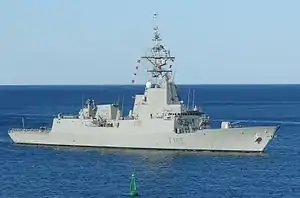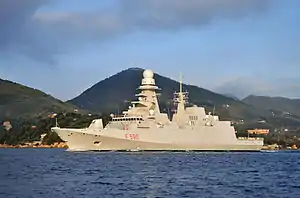Constellation-class frigate
The Constellation class is a class of multi-mission guided-missile frigates under development for the United States Navy as a follow-on to the modular littoral combat ship.[5] The Navy announced the FFG(X) frigate project in the United States Department of Defense Request For Information (RFI) on 10 July 2017.[4][6] The U.S. Navy had selected five shipbuilders to evolve their designs into a prospective design for the proposed twenty FFG(X) guided-missile frigates.[7] On 30 April 2020, it was announced that Fincantieri Marinette Marine had won the contract.
_artist_rendering%252C_30_April_2020_(200430-N-NO101-150).JPG.webp) Artist rendering of the final Constellation-class design | |
| Class overview | |
|---|---|
| Name: | Constellation class |
| Builders: | |
| Operators: |
|
| Preceded by: |
|
| Cost: | US$795 million[1] (first unit) |
| Planned: | 15[2] |
| General characteristics | |
| Type: | Guided missile frigate |
| Displacement: | 7,400 short tons (6,700 t) |
| Length: | 496 ft (151.18 m) |
| Beam: | 65 ft (19.81 m) |
| Draft: | 26 ft (7.92 m) |
| Propulsion: | CODLAG |
| Speed: | in excess of 26 kn (48 km/h; 30 mph) |
| Range: | 6,000 nmi (11,000 km; 6,900 mi) at 16 kn (30 km/h; 18 mph) (electric drive) |
| Boats & landing craft carried: | 2x rigid-hulled inflatable boats |
| Capacity: | 200 accommodations |
| Complement: | 140 crew |
| Sensors and processing systems: |
|
| Armament: |
|
| Aircraft carried: |
|
Design
.png.webp)
The U.S. Navy’s intention to buy the first FFG(X) in 2020 does not allow enough time to develop a completely new design for the FFG(X). Consequently, the Navy intends for the design of the FFG(X) to be a modified version of an existing "parent" ship design.[5]:8 The RFI says, "A competition for FFG(X) is envisioned to consider existing parent designs for a Small Surface Combatant that can be modified to accommodate the specific capability requirements prescribed by the U.S. Navy."[4]
The U.S. Navy wants a frigate that can keep up with the aircraft carriers and have sensors networked in with the rest of the fleet to expand the overall tactical picture available to the group. "The FFG(X) will normally aggregate into strike groups and Large Surface Combatant led surface action groups but also possess the ability to robustly defend itself during conduct of independent operations while connected and contributing to the fleet tactical grid."[4]
In January 2019, the U.S. Navy announced that the new frigate will have a minimum of 32 Mark 41 Vertical Launch System cells aboard the ship for primarily anti-air warfare for self defense or escort missions.[8]
The U.S. Navy would like for the ship to be able to:
- Destroy surface ships over the horizon,
- Detect enemy submarines,
- Defend convoy ships,
- Employ active and passive electronic warfare systems,
- Defend against swarming small boat attacks.[4]
The class will utilize a Combined Diesel Electric and Gas Hull, Mechanical and Electrical (HM&E) propulsion system which has never been used in any other Navy ship.[9] The new propulsion system will be required to be tested on land, in order to reduce the risk of engine failure, which has plagued the previous LCS program.[9]
Development
The Navy wants to procure the first FFG(X) in FY2020, the next 18 at a rate of two per year in FY2021-FY2029, and the 20th in FY2030. The Navy’s proposed FY2020 budget requests $1.281 billion for the procurement of the first FFG(X). The Navy’s FY2020 budget submission shows that subsequent ships in the class are estimated by the Navy to cost roughly $900 million each in then-year dollars.[10]
Contenders
Six shipbuilders submitted proposals for conceptual designs to the U.S. Navy FFG(X) Frigate program.[3][11] On 16 February 2018, the U.S. Navy announced that from these proposals they had selected five shipbuilders and awarded them each $15 million contracts to produce conceptual designs for the FFG(X).[7] These shipbuilders were Austal USA, Fincantieri Marine Group, General Dynamics, Huntington Ingalls Industries, and Lockheed Martin.[7] Atlas North America submitted the MEKO A-200 but was not selected for a conceptual design contract.[3][7] Ship designs from these five shipbuilders were evaluated by the U.S. Navy to inform the final specifications that would be used for the FFG(X) request for proposal in 2019 and the intended contract award in 2020.[7]
On 28 May 2019, Lockheed Martin withdrew from the competition.[12]
| Prime Contractor | Shipyard | Design | Image | |
|---|---|---|---|---|
| Austal USA | Austal USA | Austal Frigate based on the Independence-class littoral combat ship | _at_Naval_Air_Station_Key_West%252C_29_March_2010_(100329-N-1481K-298).jpg.webp) Independence class | |
| General Dynamics | Bath Iron Works | Navantia Álvaro de Bazán-class F100 frigate / destroyer |  Álvaro de Bazán class | |
| Huntington Ingalls Industries | Ingalls Shipbuilding | Patrol Frigate based on the National Security Cutter | .jpeg.webp) National Security Cutter | |
| Lockheed Martin | Marinette Marine | Lockheed frigate based on the Freedom-class littoral combat ship |  Freedom class | |
Winning selection | ||||
| Fincantieri | Marinette Marine | based on the Italian Bergamini class of the Italian/France FREMM multipurpose frigate program |  Italian version of FREMM-class frigate | |
Contract award
On 30 April 2020, it was announced that Fincantieri Marinette Marine's FREMM multipurpose frigate had won the contest and was awarded a $795 million contract for detailed design and construction of the lead ship, with options for nine additional ships.[1]
Naming
On 8 April 2020, it was revealed that four proposed names were put forward by outgoing acting Secretary of the Navy, Thomas Modly. He expressed a desire for the first ship to be named Agility with the class designated Agility class. Other names put forward were Intrepid, Endeavor, and Dauntless. However, Navy leaders said Modly's proposed names would not be adopted.[13] In July 2020, it was reported by The Drive that the lead ship would be named USS Brooke (FFG-80).[14] Later the U.S. Navy clarified via Twitter that reports about reusing the USS Brooke name for a new warship were erroneous.[15] On 7 October 2020, Navy Secretary Kenneth Braithwaite announced the first FFG(X) frigate would be named USS Constellation (FFG-62).[16][17] On 2 December 2020, Secretary Braithwaite announced that the second ship of the class will be named USS Congress (FFG-63).[18][19] On 15 January 2021, Secretary Braithwaite announced that the third ship of the class will be named USS Chesapeake (FFG-64).[20] All three ships are named after three of the Navy's original six frigates.[20]
Ships in class
| Name | Hull Number | Builder | Laid Down | Launched | Commissioned | Status |
|---|---|---|---|---|---|---|
| Constellation | FFG-62 | Fincantieri Marinette Marine | Scheduled to start construction, | |||
| Congress | FFG-63 | Announced[18][23] | ||||
| Chesapeake | FFG-64 | Announced[20][24] |
References
- Eckstein, Megan (30 April 2020). "Fincantieri Wins $795M Contract for Navy Frigate Program". USNI News. Retrieved 30 April 2020.
- Osborn, Kris (2021-01-06). "Navy plans to build 15 new Constellation-class frigates in next 5 years". Fox News. Retrieved 2021-01-16.
- Vavasseur, Xavier, ed. (18 January 2018). "SNA 2018: Contenders for the U.S. Navy FFG(X) Frigate Program". Navy Recognition. Retrieved 19 January 2018.
- Larter, David B. (10 July 2017). "Frigate competition wide open: Navy specs reveal major design shift". Defense News. Sightline Media Group. Retrieved 19 January 2018.
- O'Rourke, Ronald (8 December 2017). "Navy Frigate (FFG[X]) Program: Background and Issues for Congress" (PDF). Congressional Research Service. Retrieved 17 February 2018.
- Eckstein, Megan (10 July 2017). "Navy Releases Details of New FFG(X) Guided-Missile Frigate Program in Request to Industry". USNI News. U.S. Naval Institute. Retrieved 17 February 2018.
- LaGrone, Sam; Eckstein, Megan (16 February 2018). "Navy Picks Five Contenders for Next Generation Frigate FFG(X) Program". USNI News. U.S. Naval Institute. Retrieved 17 February 2018.
- LaGrone, Sam (2019-01-22). "Navy Squeezing Costs Out of FFG(X) Program as Requirements Solidify". USNI News. Retrieved 2019-02-09.
- Larter, David B. (2020-12-06). "Citing littoral combat ship failures, Congress pushes the US Navy to get FFG(X) right". Defense News. Retrieved 2021-01-16.
- "Report to Congress on U.S. Navy Frigate FFG(X) Program". USNI News. 2019-10-18. Retrieved 2019-10-19.
- "Contracts" (Press release). U.S. Department of Defense. 16 February 2018. CR-032-18. Retrieved 17 February 2018.
…six offers received.
- LaGrone, Sam (28 May 2019). "Lockheed Martin Won't Submit Freedom LCS Design for FFG(X) Contest". USNI News. Retrieved 28 May 2019.
- Werner, Ben (8 April 2020). "Navy Leaders Sink Ship Names Proposed in SECNAV Modly's Last Days". USNI News. Retrieved 17 July 2020.
- Trevithick, Joseph (17 July 2020). "Pentagon Notice Says The First Of The Navy's New Frigates Will Be Named USS Brooke". The Drive. Retrieved 17 July 2020.
- "No, the US Navy will not name first of new class of frigates USS Brooke". Defense Brief. 18 July 2020. Retrieved 7 October 2020.
- "SECNAV Names Navy's Newest Class of FFG(X) Ships". United States Navy. 2020-10-07. Retrieved 2021-01-16.
- Eckstein, Megan (7 October 2020). "SECNAV Braithwaite Names First FFG(X) USS Constellation". USNI News. U.S. Naval Institute. Retrieved 7 October 2020.
- "SECNAV Names Future Guided Missile Frigate USS Congress". United States Navy. 2020-12-04. Retrieved 2021-01-16.
- Ziezulewicz, Geoff. "Navy bringing back U.S. Atlantic Fleet". Navy Times. Sightline Media Group. Retrieved 2 December 2020.
- "SECNAV Names Future Vessels while aboard Historic Navy Ship". United States Navy. 2021-01-15. Retrieved 2021-01-16.
- "SECNAV Braithwaite Announces Name of New Frigate Class". 2020-10-07. Retrieved 2021-01-16.
- LaGrone, Sam (2021-01-16). "Navy: First Constellation Frigate Will Start Fabrication This Year as Shipyard Expands". USNI News. Retrieved 2021-01-16.
- Harkins, Gina (2020-12-03). "The Navy is Naming its Next New Frigate USS Congress". Military.com. Retrieved 2021-01-16.
- "Secretary of the Navy Kenneth J. Braithwaite - Growing the Fleet". 2021-01-15. Retrieved 2021-01-16.
![]() This article incorporates public domain material from websites or documents of the United States Government.
This article incorporates public domain material from websites or documents of the United States Government.
External links
- RFI Solicitation Number: N0002418R2300 - 2017-07-10; response by 24 August 2017